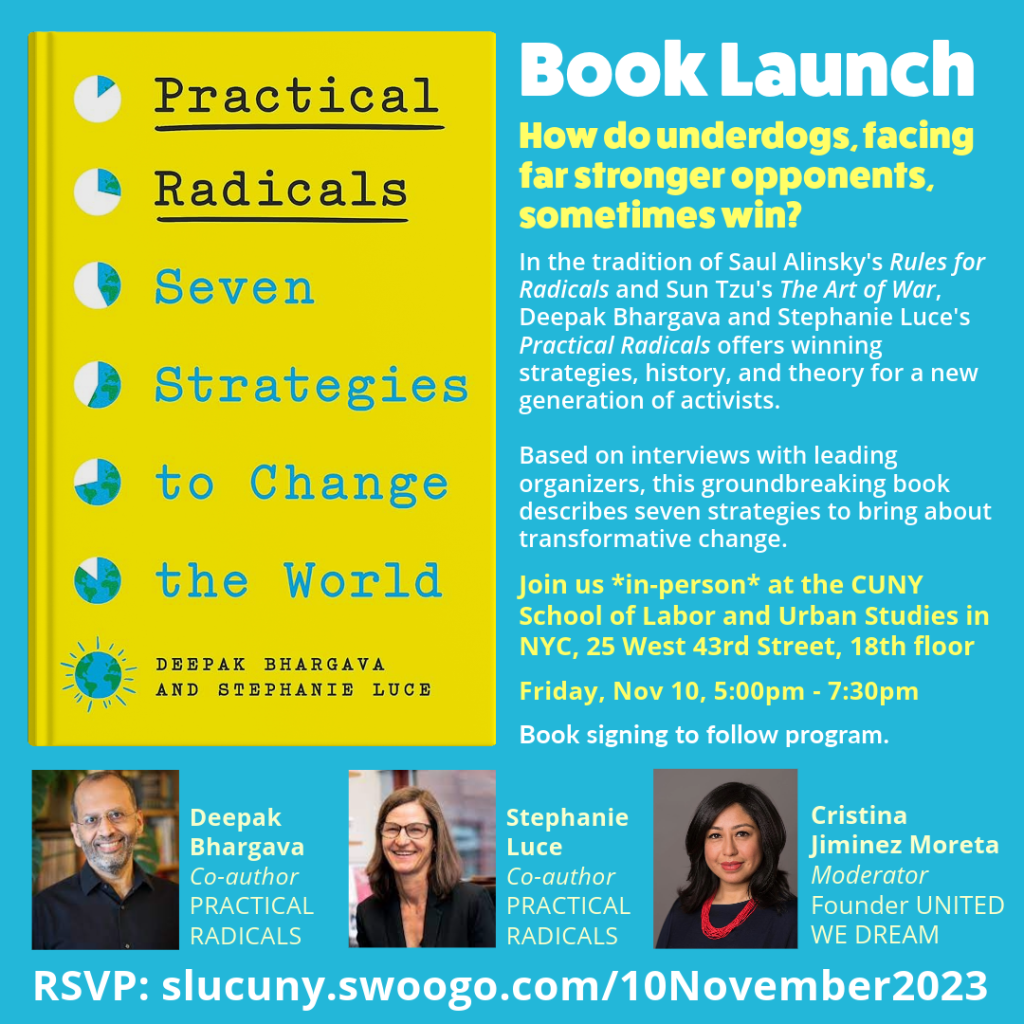We’ve launched a new podcast, Practical Radicals, based on our book Practical Radicals: Seven Strategies to Change the World. Deepak Bhargava and I will talk with progressive organizers and thinkers today and share insights crucial for the fight to build a better society. Find the podcast, along with the discussion guide and other information on our new book website.
Author: Stephanie Luce
Practical Radicals Op-eds
The Narrative of Bidenomics isn’t Sticking because it Doesn’t Reflect Americans’ Lived Experiences, Forbes, January 8, 2024
Why We Need Bayard Rustin’s Practical Radicalism Today, Inequality.org, November 17, 2023 (also appears on Common Dreams and Counterpunch)
Social Change Movements Are Winning Big, Thanks to Rigorous Strategy, Newsweek, November 16, 2023
How Today’s Underdogs Can Win Big With Strategy (Book Excerpt), The Forge, and Convergence, November 15, 2023
To Win Big, Progressives Need to Up Their Strategy Game, The Nation, November 6, 2023
Organizing In a Time of Anxiety: Taking Inspiration From the Gay Men’s Health Crisis, The Advocate, November 6, 2023
Practical Radicals Interviews
Deepak Bhargava and I have been honored to speak about Practical Radicals with several esteemed journalists and organizers.
How can activists change the world? Experts offer seven strategies – interview with Steven Greenhouse, The Guardian, December 17, 2023
Our Political Opponents Know How to Build Power. We Should, Too. – interview with Emma Tai, In These Times, December 14, 2023
New book paints 350.org as model for social change – Robin Bravender, Politico/ E&E News, November 28, 2023
Practical Radicals Podcasts
Deepak Bhargava and I speak about Practical Radicals with Nathaniel Pearlman on his podcast the Great Battlefield. November 18, 2023
Join us for a conversation with Stephen Pimpare, on New Books Network. December 1, 2023
America Trends podcast with Larry Rifkin. Episode 720, December 28. 2023.
Discussion Guide now out!
We’ve created a discussion guide for Practical Radicals: Seven Strategies to Change the World, now available online and ready for download. The guide includes questions to use in a group study as well as copies of all handouts in the book.
Book Launch!
Join us November 10 to celebrate the launch of our new book, Practical Radicals: Seven Strategies to Change the World. If you are in New York, join us for a reception at 5 pm. We will start the program at 6 pm. The event will also be live-streamed. Get more information and RSVP here.

Practical Radicals
Deepak Bhargava and I have written a book, Practical Radicals: Seven Strategies to Change the World, based on the class we teach at CUNY on power and strategy. The book is out November 7 from the New Press. You can learn more about the book and pre-order your copy here: https://thenewpress.com/books/practical-radicals
People-side Economics
I talked to economists, historians and analysts about what is going on in the economy. See my interviews in Convergence magazine with Robert Pollin, Heidi Shierholz, Amy Hanauer, Heather McGhee and Samir Sonti. We talk about inflation, unemployment, tax policy, the Fed, inequality, and more!
Fair Pay for Home Care
New York State is considering proposed state legislation that would raise wages for home care workers. Fair Pay for Home Care would establish a minimum base wage and provider reimbursement for home care workers at 150 percent of the highest minimum wage in each of the state’s wage regions–in practice, this would lift home care wages to a minimum of $22.50 per hour, up from as little as $13.20.
This analysis estimates the costs and savings from passing the legislation. We find that State costs would be more than offset by economic benefits. The state has the opportunity to use federal funding, which would fully cover the costs of wage increases in the first quarter of fiscal year 2023.
Gender, Race and Job Opportunities in the New York Home Care Economy
The nation’s home care workforce has more than doubled in size over the past decade, and rapid growth will continue as the population ages. But home care jobs are underpaid, physically and emotionally demanding, and often involve unpredictable hours. As a result, even before the pandemic, the home care field suffered from high turnover and severe labor shortages.
In New York State, as many as 260,000 new home care job openings will open statewide between 2022 and 2032 due to rising demand. But low wages and poor work conditions mean that many of these jobs will see high turnover or remain unfilled altogether.
Isaac Jabola-Carolus and Ruth Milkman and I have shown that public investment in higher pay for home care would mitigate these challenges: substantial wage increases would attract more workers to the field, help to alleviate shortages, and allow older adults and people with disabilities to live in their own homes instead of institutions. New analysis, presented in this new research brief, reveals further potential impacts of such an investment. By ensuring higher wages in home care, the State can create thousands of high-quality jobs for women, people of color, and immigrants.
